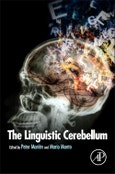The Linguistic Cerebellum provides a comprehensive analysis of this unique part of the brain that has the most number of neurons, each operating in distinct networks to perform diverse functions.
This book outlines how those distinct networks operate in relation to non-motor language skills. Coverage includes cerebellar anatomy and function in relation to speech perception, speech planning, verbal fluency, grammar processing, and reading and writing, along with a discussion of language disorders.
- Discusses the neurobiology of cerebellar language functions, encompassing both normal language function and language disorders
- Includes speech perception, processing, and planning
- Contains cerebellar function in reading and writing
- Explores how language networks give insight to function elsewhere in the brain
Please Note: This is an On Demand product, delivery may take up to 11 working days after payment has been received.
Table of Contents
Chapter 1: The Phonetic Cerebellum: Cerebellar Involvement in Speech Sound Production Wolfram Ziegler
Chapter 2: The Role of the Cerebellum in Speech Perception and Language Comprehension Ingo Hertrich, Klaus Mathiak, and Hermann Ackermann
Chapter 3: The Cerebellum and Verbal Working Memory Cherie L. Marvel and John E. Desmond
Chapter 4: Cerebellum and Verbal Fluency (Phonological and Semantic) Marco Molinari and Maria Leggio
Chapter 5: Cerebellum and Grammar Processing Michael Adamszek and Kenneth C. Kirkby
Chapter 6: Cerebellar-Induced Aphasia and Related Language Disorders Kim Van Dun and Peter Mariën
Chapter 7: Analysis of Speech and Language Impairments in Cerebellar Disorders Florian Bodranghien
Chapter 8: Cerebellum and Writing Kim Van Dun, Dorien Vandenborre, and Peter Mariën
Chapter 9: The role of the Cerebellum in Developmental Dyslexia Catherine J. Stoodley
Chapter 10: Conceptualizing Developmental Language Disorders: A Theoretical Framework Including the Role of the Cerebellum in Language-Related Functioning Leonard F. Koziol, Lauren A. Barker, and Laura Jansons
Chapter 11: Posterior Fossa Syndrome (PFS) and Cerebellar Mutism Thora Gudrunardottir, Hyo-Jung De Smet, Lisa Bartha-Doering, Kim van Dun, Jo Verhoeven, Philippe Paquier, and Peter Mariën
Chapter 12: Functional Linguistic Topography of the Cerebellum Catherine Stoodley and Jeremy D Schmahmann
Chapter 13: Deep Cerebellar Nuclei (DCN) and Language Christophe Habas, Kim van Dun, Mario Manto, and Peter Mariën
Chapter 14: The Use of Transcranial Magnetic Brain Stimulation to Study Cerebellar Language Function Alan A Beaton, Louise Allen-Walker, and R. Martyn Bracewell
Chapter 15: Experimental Use of Transcranial Direct Current Stimulation (tDCS) in Relation to the Cerebellum and Language Georgios P. D. Argyropoulos








